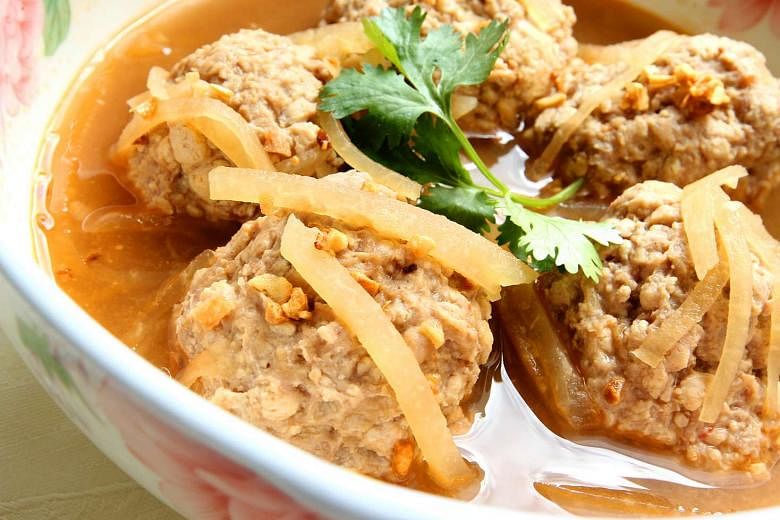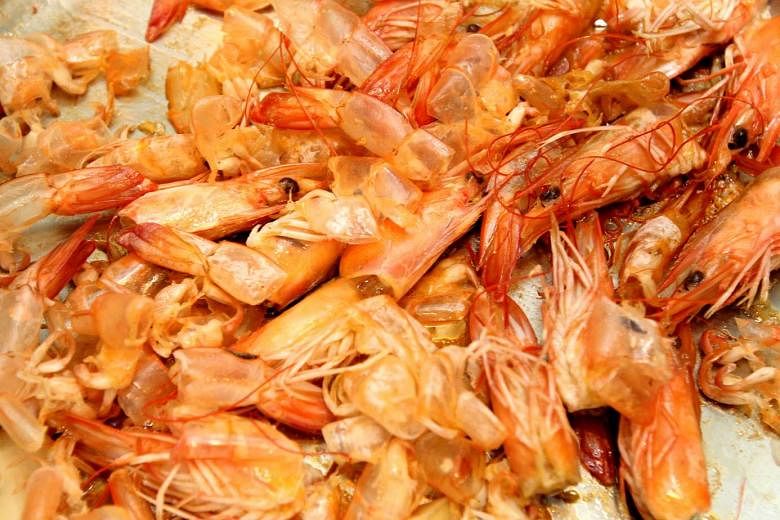This story was first published in The Sunday Times on Jan 15, 2012.
It is past midnight, the first tingling hour of the Chinese New Year. I am five or seven or 12 - it is a scene that replays itself all through my childhood.
Lying in bed, I drunkenly inhale the deep, earthy aroma of a soup bursting with giant meatballs made of ground pork, prawns and tau kwa (bean curd cakes), and spiked with that magical fermented soy bean paste called tau cheo.
My father would have completed his New Year's Eve night ritual of making pong tauhu soup, that staple of the Peranakan family's Chinese New Year table along with other dishes such as ayam buah keluak (chicken stew with black nuts) and itek tim (duck soup with salted vegetables).
-
THE OON FAMILY'S PONG TAUHU
-
INGREDIENTS
1kg prawns, peeled and minced, save heads for soup stock
10 cloves of garlic, chopped finely
4 Tbs tau cheo (salted soya beans), beans must be pounded to a paste-like consistency
12 to 14 cups of water
2 cans cooked winter bamboo shoots, cut to 3cm-long strips
White pepper
Pinch of sugar
1kg minced pork
3 large tau kwa (firm tofu), crushed finely by wrapping in cloth, squeezing out excess water
2 egg whites -
METHOD
1. Stir-fry prawn heads until crisp. Remove from wok. Pound or grind to extract the juices, add a bit of water and strain. Set aside the liquid for the soup.
2. Fry garlic with tau cheo till fragrant. Set aside three-quarters of the mixture for meatballs. To the rest, add about two cups of water and bring to boil. Add bamboo shoots, then the liquid from the prawn heads. Add about 10 to 12 cups of water to make soup.
Bring to boil, seasoning with white pepper and sugar to taste.
3. To make the meatballs, combine the tau cheo and garlic mixture with the prawns, pork, tau kwa and egg whites. Season with white pepper. Mix well. Form the meatballs - you should be able to make about 40, each the size of a snooker ball. Add to the boiling soup. Simmer for 10 minutes until the meatballs float to the top.
4. Serve hot in bowls, garnished with coriander leaves, and sambal belacan at the side.
Serves 12.
A huge vat of pong tauhu would be simmering away on the stove in our flat, its smells blanketing the whole house.
I do not recall much of the other dishes - they were either already made and in the refrigerator, or to be cooked the next morning - but it was the hearty meatball soup with slivers of bamboo shoots that found its way into my heart.
To me, it is not just a Chinese New Year dish, but comfort food that I could eat all year round, with nothing else apart from a bowl of white rice and a dash of sambal belacan (shrimp chilli paste).
And indeed, my father used to indulge me by making pong tauhu - a deceptively simple but actually quite nuanced and laborious dish - a few times a year. (My mother, who is Hokkien, hardly cooks.) However, he retired his pots and pans several years ago because of old age.
As 2012 came round and my only 13-month-old daughter began toddling around the house, I decided it was time for me to step up to the plate and master an old-school classic that, for some reason, is now rarely served at Straits Chinese restaurants.
Food writer and cookbook author Chris Tan, who also comes from a Peranakan family, attributes this to the "attention to detail of each step". For example, the tau kwa for the meatballs should be crumbled by hand, wrapped in cloth and squeezed to get rid of the excess moisture. Otherwise, the meatballs will be too delicate and break apart in the soup - imagine the look of horror from a traditional Peranakan bibik.
The more common dish at restaurants is its easier-to-prepare cousin, bakwan kepeting (crabmeat ball soup), where crabmeat replaces the prawns and tau kwa, no tau cheo is used and the soup usually contains way too much white pepper.
Though I consider myself an average cook and far from a domestic goddess, I was prepared to make the effort for pong tauhu. I had made it once, 10 years ago, while studying in London and using whatever ingredients were available there, but it was far from authentic.
My father, a retired postmaster, picked up the recipe from his mother, my late grandmother, a typical Nonya matriarch who spoke only Baba Malay, the patois of the Straits Chinese. The recipe was never written down or formally taught to him; he just intuitively imbibed it from skulking around the kitchen in his growing up years, watching and tasting.
If nothing else, I want to record the exact quantities of pork, prawns and tau kwa that go into the meatballs. From cooking it together with my dad last week, I learn that there should be roughly equal amounts of each ingredient to hit the right balance of flavours and textures, that sweet spot of firmness, tenderness and bite.
The soup should be crowded with snooker ball-sized meatballs, which are a veritable meal in themselves.
Think of it as a rich and robust stew, rather than a Chinese-style consomme where broth is everything and the meats have been leeched of their flavour.
Another one of the recipe's finer points is how the prawn stock is made: not by steeping whole prawn heads in the soup but by stir-frying the heads till they are crisp, pounding them, adding a bit of water and then straining the mixture, so that only the juices are added to the soup stock. My dad says it is more hygienic this way.
When I was a child, I remember seeing him bash the prawn heads in a traditional stone pestle and mortar, or batu lesong, one of the most ubiquitous items in a Nonya kitchen. In recent years, he has simply put the heads through a grinder.
Over the years, my dad has simplified the recipe without compromising on taste. Unlike my grandmother, who minced the pork herself with a cleaver and used fresh bamboo shoots - now rarely found at wet markets or supermarkets - he buys ready-minced pork and canned winter bamboo shoots, which do not have the stink of other canned shoot varieties.
Making a good pong tauhu requires time, sensitivity and experience rather than virtuosic skill, which suits me fine.
There are no carcasses to carve, no dance with a wok over a hot flame, no fancy plating of a finished dish.
A few minutes after the meatballs float to the top of the soup, they are done. But like good braises and soups which keep for a day or two, this tastes even better after some time in the fridge and several reheats.





